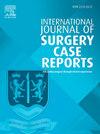Spontaneous uterine rupture in the second trimester with fetal Cyclopia at a resource-limited setting: A case report
IF 0.6
Q4 SURGERY
引用次数: 0
Abstract
Introduction and importance
Spontaneous uterine rupture in the second trimester is a rare and life-threatening obstetric emergency, typically associated with pre-existing risk factors. This case presents a unique instance of spontaneous uterine rupture in a multiparous woman without typical risk factors, highlighting the challenges of diagnosis and management in a resource-limited setting. The associated fetal cyclopia adds to the rarity of the case and contributes to the existing literature on uterine rupture. This report demonstrates the need for high clinical suspicion and prompt intervention, even in the absence of usual risk factors.
Case presentation
A 30-year-old, gravida 7, para 6 female presented with a two-day history of abdominal pain, vomiting, and subjective fever. The patient progressed to hemodynamic instability, vaginal bleeding, and loss of consciousness within a few hours of admission.
Clinical discussion
The main diagnosis was spontaneous uterine rupture with hemoperitoneum and a non-viable fetus with cyclopia. The therapeutic interventions included emergency exploratory laparotomy, evacuation of the hemoperitoneum, and subtotal hysterectomy. The patient recovered well and was discharged on postoperative day five.
Conclusion
This case underscores the unpredictable nature of uterine rupture and the importance of maintaining a high index of suspicion for this diagnosis, even in the absence of typical risk factors, particularly in resource-limited settings. Prompt surgical intervention and appropriate postoperative care are essential for favorable maternal outcomes.
在一个资源有限的环境中,妊娠后三个月自发性子宫破裂并伴有胎儿脐带绕颈症:病例报告
本文章由计算机程序翻译,如有差异,请以英文原文为准。
求助全文
约1分钟内获得全文
求助全文
来源期刊
CiteScore
1.10
自引率
0.00%
发文量
1116
审稿时长
46 days

 求助内容:
求助内容: 应助结果提醒方式:
应助结果提醒方式:


